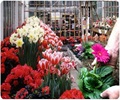Where is global warming, Bush and company could ask. But experts have begun to advise US gardeners across the country to adapt Or settle for disasters.
Todd Forrest, vice president for horticulture and living collections with the New York Botanical Garden, says."That means planting smarter and planting for the future," he said. "The first thing gardeners can do is understand they'll have to live with elevated temperatures, including higher nighttime temperatures. In winter, they'll have less snowfall. Those two changes will have a significant impact on what we can grow."
Plants are greening earlier and blooming sooner. They're also lasting longer because of extended growing and frost-free seasons. Heat waves are more intense and frequent, speeding evaporation and drying soils. Birds and butterflies are breeding and migrating earlier. Many wildlife and plant species are extending their ranges to higher elevations and more extreme latitudes.
Why talk of climate change coming, it is already changed, says, Page Spencer, chief of natural resources at Lake Clark National Park & Preserve in Southwest Alaska.
"This is a visible and conscious thing in my lifetime," Spencer said. "We're growing apples in Anchorage now and we've never been able to do that before."
A gradual warming -- generally attributed to greenhouse gas emissions produced by burning fossil fuels -- has been charted for several decades. But the climate's unpredictability is increasing, too.
Advertisement
For starters, gardeners across the country should "take a hard look at bending (hardiness) zones to bring new plants into their yards," said Forrest.
Advertisement
Keep an eye on plants that need cold and may suffer as winters get warmer, said David Wolfe, a professor of plant ecology at Cornell University and a climate change adviser to the New York Botanical Garden.
"Fruit crops all require some duration of cold winter temperatures to bloom and to produce fruit the following spring and summer," Wolfe said. As temperatures warm, he said, "Apple and berry growers, among others, may have to change crops or at least some varieties."
Prepare to set aside larger chunks of leisure time for weeding. Warmer days and nights will speed the maturity of any foods we grow -- and also help along many aggressive weeds like kudzu, garlic mustard, poison ivy and purple loosestrife.
Gardeners also should bone up on pest control. New types of biting insects and plant pests, including locusts, gypsy moths, bagworms, and disease-carrying aphids and mites, may accompany any significant temperature rise.
"Those of us living in the northern part of the United States, whether gardeners or farmers, have it easy compared to those south of us with plant pests," Wolfe said. "A lot of (pests) get killed off in winter. But as we get warmer winters, we're getting a higher incidence of plant pests."
Gardeners could adapt by increasing their use of pesticides. "But of course, this has a potential environmental and food safety cost, as well as economic cost," Wolfe said.
Since erratic precipitation patterns are expected to bring droughts followed by deluges, consider planting succulents to survive dry periods. And add rain gardens -- shallow depressions containing water-tolerant plants -- to absorb the flow from heavy downpours.
"That runoff will carry not only acids but pesticides and insecticides into our local waterways," said Patty Glick, a senior global warming specialist with the National Wildlife Federation in Seattle. "Gardeners should work to capture some of that water." Finally, prepare soil properly, minimizing tillage to avoid losing valuable organic matter and over-aerating healthy soil. Experts suggest planting trees and shrubs as windbreaks, shelter for wildlife and to help hold moisture. Recycle lawn clippings and select grasses with relatively low nitrogen and water needs (Fescues over Kentucky bluegrass, for example).
Mow higher to promote better root growth. Use compost to amend poor soils. Recycle. And buy native plants, which are better suited to survive.
Source-Medindia
SRM/J







